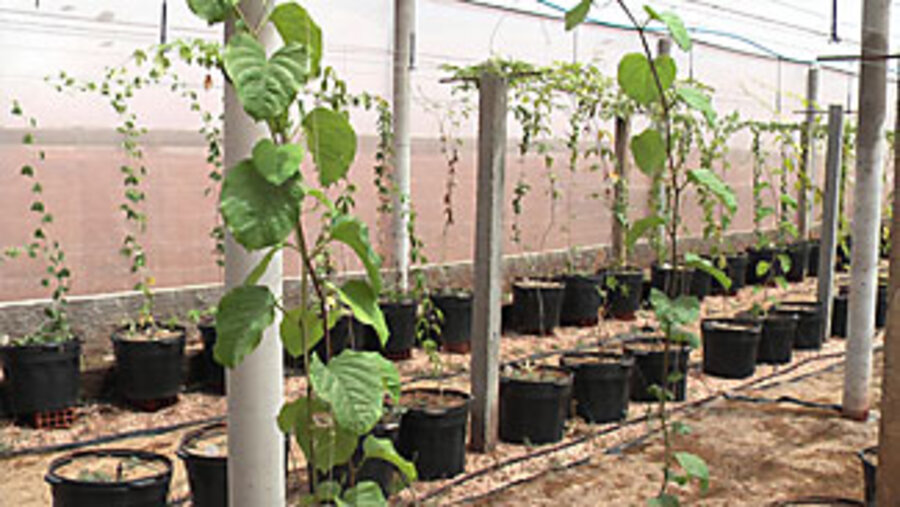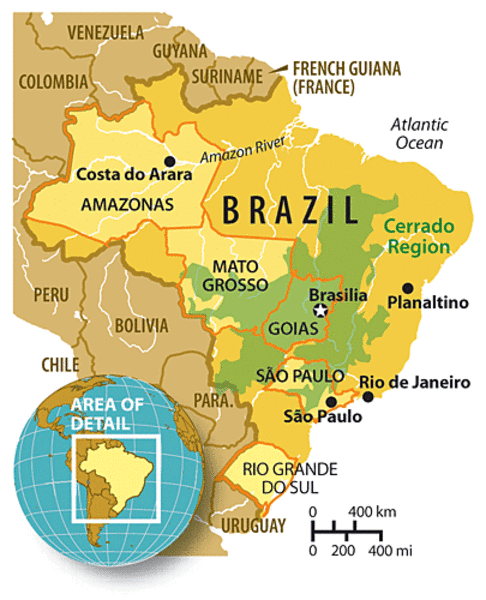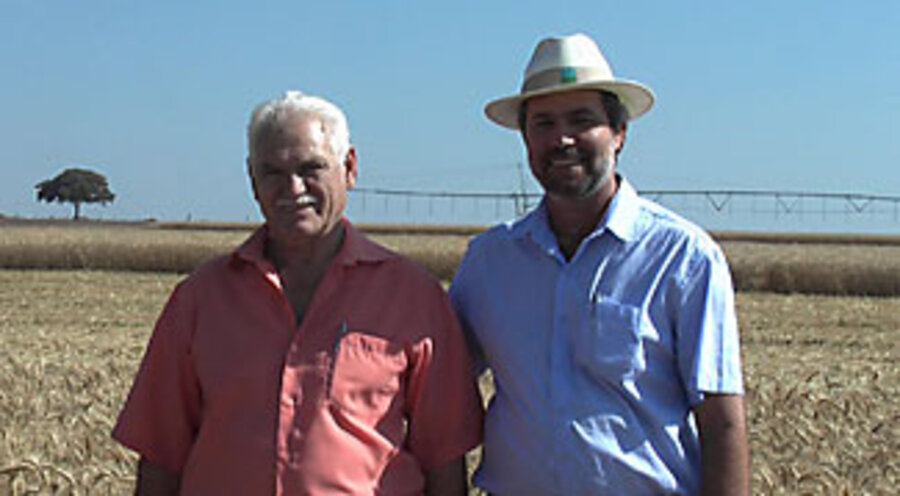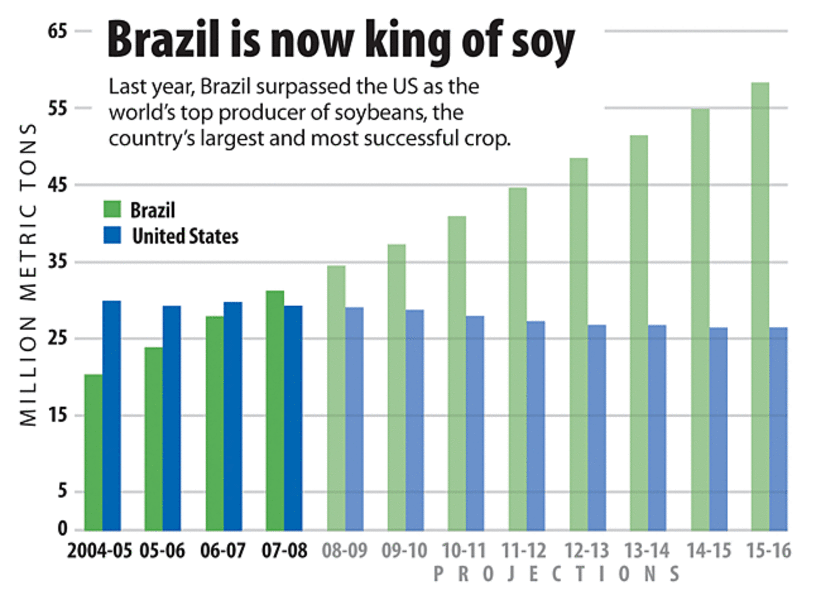Farming superpower Brazil spreads its know-how
Loading...
| Planaltino, Brazil
As a young soil scientist, Edson Lobato looked out at the vast savanna of central Brazil and imagined fields of soy, corn, and cotton where most saw an inhospitable mass of red earth and tangled trees.
His friends and family urged him to take his agronomy degree elsewhere, somewhere it would make a difference. But he joined Brazil's agricultural and livestock research agency (Embrapa) and relocated to the country's heartland, called the cerrado, where there was, at the time, little besides wooded plains, termites, and deer.
Embrapa then set out to prove that those soils could produce like the most efficient cropland of Idaho. The agency poured millions into research. It sent teams of scientists like Mr. Lobato to the American Midwest to glean as much know-how as possible.
Today his vision has helped turn Brazil into the world's largest exporter of soybeans, beef, chicken, orange juice, ethanol, and sugar.
The significance for the globe is huge. Two years ago, Mr. Lobato and two others received the World Food Prize for "one of the great achievements of agricultural science in the 20th century." As Asian diets and quality of life improve, putting pressure on available land and contributing to a spike in food prices earlier this year, Brazil could be one of the answers to the global food crisis.
Yet today it is emerging as more than just a supplier. Its scientists are now bringing the technologies of tropical agriculture to other parts of Latin America, and to Africa and Asia. In 2006, Embrapa opened its first foreign office in the West African nation of Ghana to lead the effort. Lobato assessed soils in Mozambique this year. And in May, Embrapa dispatched its first team to Venezuela to help boost food production.
"In the 1970s, '80s, and '90s, there was a lot of collaboration and support from the US and Europe," says Elisio Contini, head of Embrapa's Office of International Affairs – helping to turn Brazil into the agricultural powerhouse it is today. "Now we think it's time to transfer technology to other poor countries in Latin America and Africa. We are supporting them like the Americans supported us."
Embrapa's success is piquing curiosity worldwide. Last year, 107 international groups visited its headquarters in Brasilia.
On a recent day, a delegation from Colombia sits in Mr. Contini's office, scribbling notes as Contini details the history of the cerrado's transformation. He shows them an illustration about no-till planting – a technique that's been perfected on the vast fields of Brazil. In the presentation, dozens of tractors in V formation harvest soybeans as another line of machines, directly behind the first, sows corn. "Forty years ago, this didn't exist here," Contini tells them. "Maybe this could exist for the llanos [plains] of Colombia."
The group listens to his words intently. "Brazil has become the No. 1 exporter of beef, and we are here to see how they did it," says Manuel Gomez Vivas, who works in the economic research department of the Federation of Colombian Stockbreeders.
"Embrapa's international movement is growing fast," says Contini.
Brazil's agricultural story first begins at the Embrapa Cerrados center north of Brasilia in Planaltino, among a 3,100-hectares expanse of laboratories and fields.
It is here that scientists such as Lobato learned how to reduce acidity of the cerrado soil by applying phosphorous and lime and developed dozens of varieties of tropical soybeans, which until then had been considered only a temperate-zone crop.
Today, the cerrado accounts for 63 percent of soybean production in Brazil, the nation's largest and most successful crop.
"It was the first entity to bring vegetable or plant sources of protein to low-latitude regions," says Peter Goldsmith, executive director of the National Soy Research Laboratory at the University of Illinois. It is on a par with the "Green Revolution," he says, which refers to work started in the 1940s in the US to develop more types of wheat to feed growing populations.
In 1973, when Embrapa was founded, only a handful of employees had PhDs. Today about 1,600 have their doctorates, mostly from the US and Europe, and the agency is undergoing an expansion that will make it one of the largest agricultural centers in the world.
But research alone could not have transformed this vast savanna, which represents one-quarter of the entire landmass of Brazil. The military government of the 1970s made a calculated decision to inhabit the region by turning it into fertile farmland, giving credits and incentives to farmers in the temperate south to relocate, and inciting a mass migration of people.
That decision still remains controversial, and has grown more contentious as commodities prices have boomed over the years, spurring farmers to expand into undeveloped areas. Environmentalists have accused soy producers and cattle ranchers of degrading the cerrado and encroaching on the Amazon.
Embrapa says the challenge is real: Of all land deforested in South America, 73 percent is in Brazil, and today the fringes of the Amazon are of great concern, says Denis Minev, the secretary of planning and economic development for the state of Amazonas. But Embrapa maintains that production in the cerrado can increase on existing lands with greater efficiency, not needing expansion. Grain production in the cerrado, for example, increased 129.7 percent from 1991 to 2007, but the area harvested increased by only 25.9 percent.
That productivity will be crucial for the world, as demand from China and India grows. During the recent global spike in food prices, which incited riots around the world, the ethanol craze took much of the blame. Most was placed on the US method using corn. But some said that Brazil contributed to the problem by expanding sugarcane production for ethanol on fields that could be harvested for food crops.
Mark Lundell, the sector leader for sustainable development at the World Bank in Brasilia, disagrees. He says that because of its productivity, Brazil has actually helped keep the market supplied, and thus prices down. "In the recent crisis I don't think there is any [reason] to accuse Brazil of having contributed to world prices; they've helped to limit prices by continuing to export the main commodities," he says.
Pioneer farmers
Farmer Paulo Roberto Bonato says he's proud of the role he plays in supplying the world, even if his is just a small part. Like so many others in the cerrado today, his family hailed from the south, from the state of Rio Grande do Sul, in 1977, lured by the promise of uninterrupted space and government support. The family sold their 60-hectare farm and moved onto 300 hectares in the middle of nowhere. At the time, there were neither roads nor electricity.
Since then their operation has grown to 6,000 hectares – 10 times what they once owned – where they cultivate soy, wheat, and beans. On a recent day, Mr. Bonato drove along his farm in the state of Goias, where wheat is being harvested. "My father thought, if we stay in the south, my brothers and I will never have the chance to farm one day," he says.
Their pioneering has helped turn Brazil into one of the world's greatest agricultural success stories. Last year, agribusiness overall represented $298 billion – about 25 percent of Brazil's gross domestic product, according to the Center for Advanced Studies in Applied Economics at the University of São Paulo.
While Bonato's farm is vast, it is tiny compared with the ranches in neighboring states such as Mato Grosso, the epicenter of soy production. Last year, 5.6 million hectares were cultivated there, and the state, as well as other frontier regions, are drawing investors from around the globe. In 2000, Brazil exported $20 billion in agricultural products. Last year the number reached $58 billion. Soy exports accounted for $11.4 billion. In the state of São Paulo, the heart of sugarcane production, investors interested in the ethanol market are also swarming in. Today Brazil produces 17 billion liters of ethanol fuel, or 33 percent of worldwide production.
"If you want to play the farming business game, you need to have one foot in Brazil," says Juan Soldano, a Brasilia-based consultant for international agribusiness. The global economic slowdown is likely to curb investment, especially as commodity prices fall.
But even so, Brazil is well positioned to endure a downturn. And Embrapa estimates that it has another 90 million hectares of land that can be utilized for agriculture and 170 million hectares of degraded pastures that could be made more efficient.
Brazil's 'responsibility' to help out
"We have technology, lots of land, and above all a lot of smart farmers," says Eliseu Alves, a former president of Embrapa who is considered one of its "fathers." But, he says, Brazil must share the hard-earned secrets of its success. "Now we have the challenge of Africa. We have a great responsibility to them. Donors tried to solve the Africa problem and have failed. Now we are trying to focus on research."
It is a test Embrapa is particularly suited to take on – especially in Africa where the soil content and climatic conditions are similar. Embrapa has sent missions to Africa over the years, but a turning point came with the opening of the Ghana office in November 2006. From that base they are helping a host of agricultural departments of various countries with their specific needs.
In Angola, for example, Embrapa is helping construct a research institution modeled on their own in an effort to help improve food productivity. In other countries, they are introducing the drought-resistant varieties of wheat they are continuously improving at home.
In Venezuela, a three-member team is helping the country produce more grains, chickens, and milk – some of the products that were in short supply earlier this year. They are considering opening up a seed technology business in Central America. Earlier this fall, they were in East Timor. "The goal is to help these countries feed themselves, and then perhaps turn into suppliers," says Contini.
But it is a long slog – at least 20 or 30 years of hard work, Contini says – and it requires much more than just technology transfer. It requires training and commitment on the part of each government. Goldsmith says that the idea of turning the African savanna into anything like Brazil's cerrado, for now, is almost "a dream," he says. Land ownership issues, politics, and civil strife will hold it back. And each country must develop its own model. "Technology is transferable," says Alves. "The problem is that Africa is much more densely populated."
But it is a dream that Lobato, who retired from Embrapa and now works as a consultant, says is attainable.
This year he stood in Mozambique, as he stood in Brazil's cerrado in the 1970s. He and his colleague, Djalma Martinhão Gomes de Sousa, a pioneering soil expert of Embrapa, both say that Mozambique is where Brazil was 50 years ago. They produce some corn, and raise cattle on inefficient pastures. Production is low. Many might feel the same hopelessness that was felt about the cerrado in the '70s.
But Mr. Martinhão says that if Africa can develop its agricultural base, the continent can transform the way Brazil did: Human development index maps from the Ministry of Planning, Budget, and Management show that standards of living in the cerrado have steadily increased alongside agricultural development.
Lobato says he has little doubt that the pioneers in Africa will feel the way he feels today in his own country: "There is nothing so rewarding for myself than seeing a good crop in the field, in a place where nothing used to grow."










